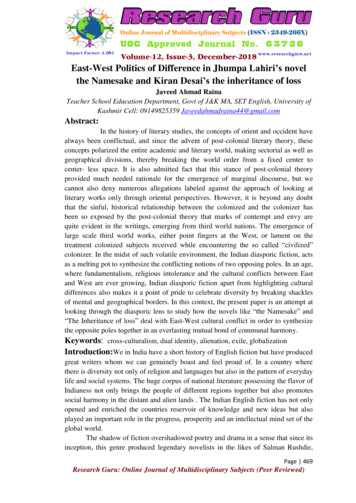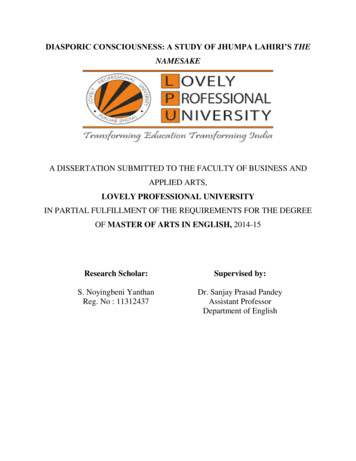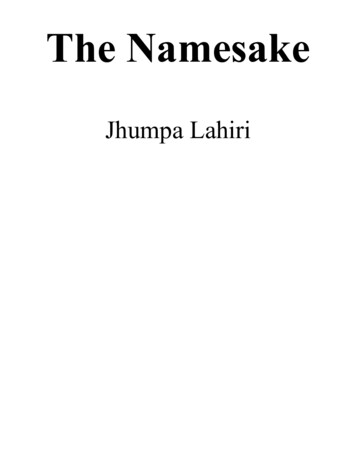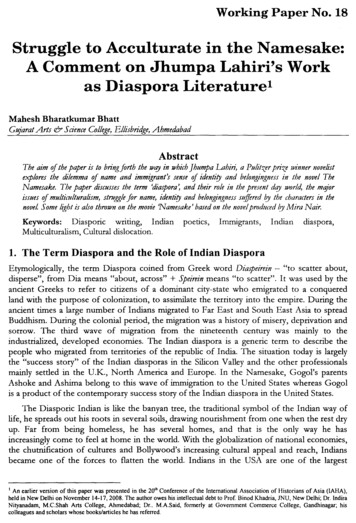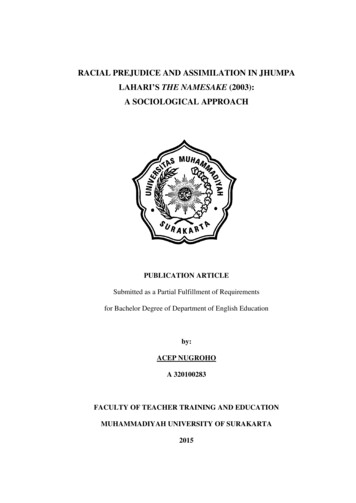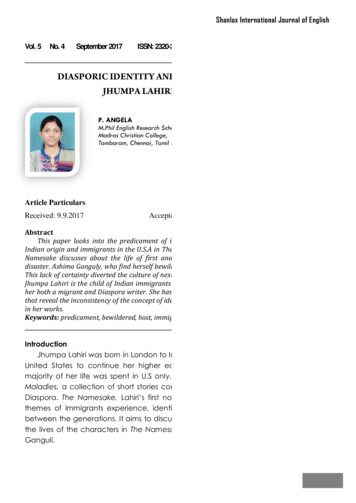
Transcription
International Journal of Research in Economics and Social Sciences (IJRESS)Available online at: http://euroasiapub.orgVol. 7 Issue 8, August- 2017ISSN(o): 2249-7382 Impact Factor: 6.939 Thomson Reuters Researcher ID: L-5236-2015Jhumpa Lahiri’s The Namesake: An Intense Diasporic ExperienceDr. Sandeep Kr. Sheoran,Assistant Professor (English),Maharaja Agrasen College, Jagadhri (Hr.)Transnational migration has emerged out as a reality and necessity in the post-colonial world. Anumber of people move from their home-lands to promise-lands, either under compulsion ordeliberations. This first generation of diasporic people tries very hard to make a balancebetween their born and gained cultures. However, the second generation melts into themainstream of the culture and strikes a balance between them, but this process is very gradualand long. Jhumpa Lahiri, an America based Indian woman writer of Indian diaspora reflects thistheme in her maiden novel The Namesake. Born in Bengal and bought up in South Kingstown,Rhode Island, she is well exposed to cultural diversities. Her diasporic experiences find differentdimensions and colours in her novels and short-stories. In spite of being raised in America, shehas inherited the sense of exile from her parents and feels the difference between two cultures.She opines “growing up in America is different. I have my own room, I can shut the door. Therewe became a part of other families, lived according to their schedule.” (Lahiri NewsweekInternational)The contrast between her Americanization and ancestral home and culture gave a ventto her creative impulse and she has presented this dilemma of past and present, native andalien, innate and acquired values in The Interpreter of Maladies (that made her won PulitzerPrize), The Namesake and Unaccustomed Earth. While talking about her recollection ofmemories, Lahiri states:I spent much time in Calcutta as a child-idle but rich time—often at homewith my grandmother. I read books. I began to write and to recordthings. It enabled me to experience solitude ironically because therewere so many people, I could seal myself off psychologically. It was aplace where I began to think imaginatively and my interest in seeingthings from different points of view. There is a legacy and tradition therewe just don’t have here. The ink hasn’t dried yet on our lives here.(Lahiri, Newsweek International)International Journal of Research in Economics & Social SciencesEmail id: editorijrim@gmail.com, http://www.euroasiapub.org532
International Journal of Research in Economics and Social Sciences (IJRESS)Available online at: http://euroasiapub.orgVol. 7 Issue 8, August- 2017ISSN(o): 2249-7382 Impact Factor: 6.939 Thomson Reuters Researcher ID: L-5236-2015On the canvass of her novels, Lahiri portrays the ground of ‘roots’ and ‘rootlessness’ in thepersonal relations of her characters. Like Bharati Mukherjee and Chitra Banerjee, Lahiri is notonly confined to married spheres, but examines the problems of exile, alienation, nostalgia,dislocation and relocation of individual in a wider range. Her characters feel trapped betweentwo worlds, and experience a constant sense of cultural displacement. In The Namesake, Gogoland Ashima feel the problem of belongingness at different places and Lahiri points out thepresence of national identity within them. While commenting over nationalism, Said makes anapt observation:We come to nationalism and its essential association with exile.Nationalism is an assertion of belonging in and to a place, a people, aheritage. It affirms the home created by a community of language, cultureand customs and by doing so; it fends off exile, fights to present itsravages. Indeed the interplay between nationalism and exile is likeHegal’s dialectic of servant and master, opposites informing andconstituting each other. (Said 176)The phenomenon of crossing the national boundaries requires a lot of adjustments fromimmigrants to adopt and imbibe the culture of foreign land. Change of ‘Culture’ is not only ageographical displacement, but a whole transformation of being. While defining ‘Culture’, T.SEliot states that it is deep, infinite, pure and imperishable like religion. He says, “‘Religion’ and‘Culture’ besides meaning different things from each other should mean for the individual andfor the group something towards which they strive, not merely something which they possess”(Eliot 31). The whole personality of the individual is determined by specific society, age,country, tradition, nationality, caste and religion. Alienation from the born culture leads to ‘fluid’or ‘fragmented identities’. In The Location of Culture, Homi Bhabha postulates that culturalalienation reinforces the feeling of “not belongingness” that reduced them to a state of “nonrecognizable entity”. Bhabha declares:Cultural difference must be understood as the free play of polarities andpluralities in the homogeneous empty time of the national community . . .The analytical of cultural difference intervenes to transform the scenarioof articulation . . . the aim of cultural difference is to rearticulate the sumof knowledge from the perspective of the signifying position of theminority that resists tantalization . . . producing other spaces of subalternsignification. (Bhabha 162)International Journal of Research in Economics & Social SciencesEmail id: editorijrim@gmail.com, http://www.euroasiapub.org533
International Journal of Research in Economics and Social Sciences (IJRESS)Available online at: http://euroasiapub.orgVol. 7 Issue 8, August- 2017ISSN(o): 2249-7382 Impact Factor: 6.939 Thomson Reuters Researcher ID: L-5236-2015The Namesake explores the psyche of both generations of immigrants—the first generation ofimmigrants manages to survive in their exile as “Indian Americans” and the second generationof immigrants accepts their predicament as “Americanized Indians”. This first group suffers thetrauma of dislocation with a sense of pride for their national heritage while the second groupfinds the foreign land as a land of opportunities and develops a romantic view towards theirhome culture. Jhumpa Lahiri clearly indicates that both these groups feel seriousdisillusionment because of emotional attachment with the homeland which often leads totrauma and its undesirable consequences like sadism, alienation and sometimes even suicide.Trauma is marked by “loss in psyche”. Commenting over Trauma, Caruth says, “Trauma isdeeply tied to our own historical realities” (Caruth 12). Mitchell further throws light over it andretorts, “Trauma creates a breach in a protective covering of such severity that it can’t be copedwith by the usual mechanism by which we deal with pain or loss . . . in trauma we are untimelyripped” (Mitchell 113).Being born in Bengali soil and Bengali tradition, and settled in America Jhumpa Lahiripresents the story of a Bengali man Ashok and his Bengali wife Ashima in The Namesake. Whilecommenting over Lahiri’s writing skills Nayar says, “Lahiri negotiates the dilemma of culturalspaces lying across the continents a master touch . . . endowed with a distinct universal appeal . . between and across two traditions, one inherited and left behind and other encountered butnot necessarily assimilated” (Nayar 03). The novel starts with the story Ashok and AshimaGanguli, when Ashok gets an opportunity to move to Boston for pursuing his PhD with ascholarship. Ashima Ganguli who is an epitome of traditional Indian woman, accompanies him.In the starting of the novel Lahiri reveals the predicament of an Indian girl who is on the vergeof marriage and being rejected often times, when an NRI boys comes to see her, she can’t hideher temptation towards him and even his shoes. Ashima when sees the shoes of Ashok at“‘dekhosession’ (in Shobha de’s term)” (Prajapati 149), she can’t resist to put her foot in it. It islike opening of an unseen, unimagined world for her. Lahiri writes:They were brown shoes with black heels and off-white laces andstitching. There was a band of lentil-sized holes embossed on either sideof each shoe . . . looking more closely, she saw the shoemaker’s namewritten on the insides, in gold lettering that had all but faded: somethingand sons, it said. She saw the size, eight and a half, and the initials U.S.A . . Ashima, unable to resist a sudden and overwhelming urge, stepped intothe shoes at her feet. (Lahiri 08)International Journal of Research in Economics & Social SciencesEmail id: editorijrim@gmail.com, http://www.euroasiapub.org534
International Journal of Research in Economics and Social Sciences (IJRESS)Available online at: http://euroasiapub.orgVol. 7 Issue 8, August- 2017ISSN(o): 2249-7382 Impact Factor: 6.939 Thomson Reuters Researcher ID: L-5236-2015After a haste marriage, Ashima Bhadudi moves to Boston as Ashima Ganguli with her husbandAshok Ganguli. Ashok in Boston is always busy in his career and Ashima is left alone with nomajor work to do. She passes her time cleaning house and moving markets. Memories of thehomeland keep on haunting her and this trauma increases with the revelation of her pregnancy.The feeling of motherhood makes her more apprehensive as she is afraid of the child loosing thecultural heritage of Bengali family in this foreign land. For an immigrant woman like Ashima, allalone with no one to call her own, motherhood becomes a burden which is quite explicit in herconfession in her labour pain:It’s not so much the pain, which she knows, somehow, she will survive.It’s the consequences: motherhood in a foreign land. For it was one thingto be pregnant, to suffer the queasy morning in bed, the sleepless nights,it is the dull throbbing in her back. . . this was happening so far fromhome, unmonitored and unobserved by those she loved, had made itmore miraculous still. But she is terrified to raise a child in a countrywhere she is related to no one, where she knows so little, where lifeseems so tentative and spare. (Lahiri 06)Lahiri records that how it is emotional need more than physical pain that is bothering Ashima.She is missing all her near and dear ones who might have been a support to her in these crucialmoments. When she listens one English couple saying ‘I love you’ to each other, she can’t expecther husband saying the same to her in public. In fact, like a good Bengali wife, she never uttersher husband name. The mental crisis of Ashima forces her to relate pregnancy and foreignnessas complementary to each other:For being a foreigner, Ashima is beginning to realize, is a sort of lifelongpregnancy – a perpetual wait, a constant burden, a continuous feeling outof sorts. It is an ongoing responsibility, a parenthesis in what had oncebeen ordinary life, only to discover that the previous life has vanished,replaced by something more complicated and demanding. Likepregnancy, being a foreigner, Ashima believes, is something that elicitsthe same curiosity from strangers, the same combination of pity andrespect. (Lahiri 49-50)The migration of women is an unquestioning acceptance of the social norms of native lands thatdefine their destinies. Perhaps the most significant aspect that distinguishes narratives of malemigration from female migration is choice: choice of males and the force behind females’International Journal of Research in Economics & Social SciencesEmail id: editorijrim@gmail.com, http://www.euroasiapub.org535
International Journal of Research in Economics and Social Sciences (IJRESS)Available online at: http://euroasiapub.orgVol. 7 Issue 8, August- 2017ISSN(o): 2249-7382 Impact Factor: 6.939 Thomson Reuters Researcher ID: L-5236-2015migration. Rushdie himself confesses that the immigrant experiences of women writings aredefinitely different from men’s writings. That’s why he says, “Having been borne across theworld, we are translated men” (17). The diasporic literature is focused on the study of men andwants to explore the experiences of men as men, as son, as husbands, as fathers, as exploitedand even as exploiters. So, whether it is the craving of Mr. Biswas to build a house of his own inA House of Mr. Biswas or Ralph Singh of The Mimic Men to claim his identity in the larger world,it is man only who are focused. Man decides and woman follows.Women are not the primary agents of emigration because the diasporic experience isone that is forced on them by the circumstances of their choice-less marriages and customs ofnative land – but they emerge, through this experience, as evocative symbols of a new andaspirational more justly ordered society when compared to their native societies. ChandraTalpade Mohanty argues that “being a woman has political consequences in the world we livein; that there can be unjust and unfair effects on women depending on our marginality and/orprivilege” (Mohanty 03). Diasporic novelists like Monica Ali and Jhumpa Lahiri propose that theabsence of the boundaries of home, lost through exile, allows the vision for transformation aswell as trans-creation and hence, the creation of modern, contextual identities.Ashima like Nazneen of Brick Lane share the classic ‘insider’/‘outsider’ perspectives ofimmigrant lives and both narrate the experiences of alteration and confusion. The liveddifferences of their lives alter their physical spaces and create new areas; thus, Brick Lane inLondon (Ali) and Cambridge in Massachusetts (Lahiri), which are initially depicted as alien, are,through the course of the novels, transformed into spaces chosen as homes by the protagonists.Indeed, it could also be argued that it is precisely Nazneen’s and Ashima’s positions as‘insiders’/ ‘outsiders’ that permit the double‐consciousness which allows them to cross bordersof various kinds. The idea of selecting an identity, defined by context and culture, rather thaninheriting it, is increasingly finding support among contemporary diasporic thinkers who arethemselves products of this hybridization. Nobel Laureate economist, humanist and well knowndiasporic personality, Amartya Sen, suggests that:History and background are not the only way of seeing ourselves and thegroups to which we belong identities are robustly plural, and theimportance of one identity need not obliterate the importance of others.(Sen 19)After the birth of his son, the biggest problem of Ashok is to name him, as it is impossible inAmerica to get Ashima released from hospital without a proper name to the child. It is theearnest desire of Ashima that her new born son must be named by her grandmother asaccording with custom of Bengali tradition. Her temptation to choose a Bengali name given byInternational Journal of Research in Economics & Social SciencesEmail id: editorijrim@gmail.com, http://www.euroasiapub.org536
International Journal of Research in Economics and Social Sciences (IJRESS)Available online at: http://euroasiapub.orgVol. 7 Issue 8, August- 2017ISSN(o): 2249-7382 Impact Factor: 6.939 Thomson Reuters Researcher ID: L-5236-2015her grandmother is the symbolic triumph of her Indian values over Americanization. It is thecommon practice of Indian immigrants to patronize and adore all that is Indian in nature asSanjukta Dasgupta says, “the resident or nonresident Indian will invariably prioritize his or herregional identity and culture” (Dasgupta 76). Not so emotional, American society can’t accept adakname or pet name for the discharge of the baby. Ashima finds herself in fix as in Bengalisocial rituals, the custom of assigning the name is mandatory. Here, the episode of naming is notmerely part of the story; Lahiri uses it for a special purpose. While highlighting the significanceof the episode, Beena Agarwal states:Lahiri admits that the name has become a complete metaphor of humanidentity inclusive of one’s national, social, moral, religious and culturalidentity and the carminative effect of them constituting theconsciousness of “identity” and “belongingness”. The official names areselected with the rare aspiration to determine the future of the child.(Agarwal 114)Finding no way out Ashok names the child, Gogol, after the name of a famous Russian writer,Nikolai Vaselievich Gogol, as once this writer in one way or the other acted as life-saver toAshok. Ashok conceives it as his second-birth and the name fortunate. The name may be dear tothe father, but the son feels disgusted with it to a great extant, as it is neither Indian and norAmerican. However, when Gogol went to school, Ashok tried to change it with ‘Nikhil’ but thechild couldn’t accept the sudden change in the name and it goes on like this only. The frustrationof Gogol increases when he comes to know that the Russian writer was a professional andpersonal failure and “pronounced a death sentence on himself, and proceeded to commit slowsuicide by starvation” (Lahiri 91). Gogol decides to change his name and when the Magistrateasks the reason, he straight forwardly says, “I hate the name Gogol” (102). It is alwaysimpossible to detach from the past. So, Gogol’s parents, friends and even the novelist addresshim as Gogol. This shifting of the name is an attempt to shift identity of immigrants. It is not onlythe crisis of Gogol but of many immigrants like him. Reena Chabbra states, “Gogol is constitutedas an epitome of an American—Indian hybrid who vacillates between his identity and Americannationality” (Chabbra 75).After changing the name, Gogol changes himself, makes girlfriends, starts exploring life,prefers to celebrate his birthdays with Maxine and feels “that here at Maxine’s side, in thiscloistered wilderness, he is free” (Lahiri 158). Gogol’s practice of comparing his family andparents with Maxine’s family and parents shows his urge for freedom and adventures life. Thefirst generations of immigrants are not so welcoming to the cultural change, but the secondInternational Journal of Research in Economics & Social SciencesEmail id: editorijrim@gmail.com, http://www.euroasiapub.org537
International Journal of Research in Economics and Social Sciences (IJRESS)Available online at: http://euroasiapub.orgVol. 7 Issue 8, August- 2017ISSN(o): 2249-7382 Impact Factor: 6.939 Thomson Reuters Researcher ID: L-5236-2015generation wants to taste the freedom and openness of the foreign land. Gogol and his sisterwere not that happy in their eight month stay in Calcutta, but here Gogol is feeling himself in thelap of nature. Many young children born and bought up in foreign feel the same way Gogol isfeeling. Lahiri says it as:The family seems to posses every piece of landscape, not only the houseitself but every tree and blade of grass. Nothing is locked, not the mainhouse, or the cabin that he and Maxine sleep in . . . it is a place that hasbeen good to them, as much a part of them as a member of the family . . .he feels no nostalgia for the vacation he’s spent with the family, and herealizes now that they were never really true vacations at all. Insteadthey were overwhelming, disorientating expedition, either going toCalcutta, or sightseeing in palaces they did not belong to and intendnever to see again. (154-155)Unfortunately the sudden demise of his father brings Gogol from where he has started. Herealizes “Nikhil evaporates and Gogol claims him again’ (106). Quite naturally, he assumes theplace of the eldest member of the family and becomes ready to marry Ashima’s choice,Maushumi leaving Maxine behind, as the former one share the same upbringing like Gogol inUSA and England. Ziauddin Sardar makes a very apt comment over this, when he says:Indeed, attempts to delink the heritage by a simple name changing, asLahiri shows so brilliantly, does not alter the fabric of a person but leadsonly to a crisis of identity and meaning. The past is ever present, Lahiriseems to be saying, and a viable future depends in recognition andappreciating this past. (Sadar 42)However, the marriage proves to be a failure because of Moushumi’s extra-marital affair.Maushumi attracts towards her old boyfriend and Gogol understands it’s time to get separated.Gogol fails to synthesize between the two worlds presented in the form of Maxine andMaushumi. His attraction towards Maushumi is only because of his mother’s desire to get herson married a Bengali cultured girl. In his three affairs Gogol fails to maintain an individualideology and adaptation as well as rejection both remains incomplete to him. Moving towardsMaushumi is like going back to “imaginary homelands’ or “The lost origin” (Rushdie (9-21). Thisin-between position for diasporic like Gogol and Maushumi is very painful. Over this McLeodcomments, “Though the children born to migrant peoples enjoy better settlement and place inInternational Journal of Research in Economics & Social SciencesEmail id: editorijrim@gmail.com, http://www.euroasiapub.org538
International Journal of Research in Economics and Social Sciences (IJRESS)Available online at: http://euroasiapub.orgVol. 7 Issue 8, August- 2017ISSN(o): 2249-7382 Impact Factor: 6.939 Thomson Reuters Researcher ID: L-5236-2015that country but “their sense of identity borne from living in a diaspora community [is]influenced by the past migrant history of their parents or grandparents” (McLeod 207) .An autobiographical vein can also be noticed in the experience of growing as a child ofthe protagonist Gogol and Jhumpa Lahiri. Like Gogol, her pet name becomes her good name andit is through it that she wants to highlight the agony of fragmented identity and loyalty. Whilecommenting over this issue Jhumpa Lahiri set her heart open to the Hollywood director of themovie, Mira Nair, “The names we have, there is so much about them: who are we and they arethe one world that exists that represents us. And yet we don’t choose them. These are from ourparents”. For Gogol, his name is a mess but for Ashok, it implies new beginning and life. Gogoltries to cope-with his father’s sentiments but fails to understand the emotional significance ofthe name. In an interview released by Houghton Mifflin Company, Lahiri makes this turmoil ofimmigrants more clear:I think that for immigrants, the challenges of exile, the loneliness, theconstant sense of alienation, the knowledge of and longing for a lostworld, are more explicit and distressing than for their children. I wantedto please my parents and meet their expectations. I also wanted to meetthe expectations of my American peers, and the expectations I put onmyself to fit into American society. It’s a classic case of divided identity.Through her characters, the novelist, Jhumpa lahiri investigates the strangeness of diasporicfeelings and conflicting ways of the life. She exposes the cultural bewilderment and struggle ofassimilation that disturbs the emotional ties between generations. The parents struggle formaintaining the culture and stopping their children becoming all American while the childrenstruggle with the parents who are all Indian and this lead to dual identity crisis. But, Gogolfinally understands that life lies in the adjustment of Indian and American culture. To fullyabandon or accept only one culture is no solution at all. The identity crisis that Ashima feels firstis transformed to her son, but at the end both learns how to strike a balance between the twocultures. Ashima decides to live the rest of her life in America as well as India. True to her name,that in English means, “one without boundaries”, she will be free from borders, resident of boththe nations, “Ashima has decided to spend six months of her life in India, six months in theStates . . . true to the meaning of her name, she will be without borders, without a home of herown, a resident everywhere and nowhere” (Lahiri 276). Like Gogol, she also becomes anamesake, without boundaries and restrictions. Thirty years in America has changed her a lot.Now, she is not the same Ashima that used to live in Calcutta. She is more confident and the factthat she is alone doesn’t bother her. From now onwards, her brother and his wife would be herInternational Journal of Research in Economics & Social SciencesEmail id: editorijrim@gmail.com, http://www.euroasiapub.org539
International Journal of Research in Economics and Social Sciences (IJRESS)Available online at: http://euroasiapub.orgVol. 7 Issue 8, August- 2017ISSN(o): 2249-7382 Impact Factor: 6.939 Thomson Reuters Researcher ID: L-5236-2015family, though she would miss the country where she has grown and loved her husband, but shewould move there as and when wanted. Lahiri writes:It is a solitary, somewhat premature version of the future she and herhusband had planned when he was alive. In Calcutta, Ashima will livewith her younger brother, Rana, and his wife, and their two grown, as yetunmarried daughters, in a spacious flat in Salt Lake. There she will have aroom, the first in her life intended for her exclusive use. (Lahiri 275)For her, America is not the place where she was born and brought up, but at the end of the novelmetaphorically, politically and consciously, she links herself to that place. It is ‘leaving home’that stimulates new frameworks of engagements, interactions and ultimately construction ofidentity – a feeling that could never have emerged in the confines of the household in thehomeland or village. Salman Rushdie in Shame opines:We have performed the act of which all men anciently dream, the thingfor which they envy the birds; that is to say, we have flown . . . look underyour feet. You will not find gnarled growth spouting through the soles.Roots, I sometimes think, are a conservative myth designed to keep us inour places. (Rushdie 90-91)Likewise, Gogol also realizes that he has inherited Indianness from his parents and assimilatedhimself in America. The weakening of one will surely not make him strong. Vertovec alsointerprets diaspora in a contemporary context and concludes that it is no longer a dangerousthing. According to him, Diaspora is a community of local and plural identities, ethnic andtransnational affiliations and celebrations of cosmopolitanism. He states:Diaspora discourse has been adopted to move collective identity claimsand community self-ascriptions beyond multiculturalism . . . thealternative agenda - advocates the recognition of hybridity, multipleidentities and affiliations with people, causes and traditions outside stateof residence. (Vertovec 05)Initially extremely sensitive about his name, Gogol understands that everything is perishable.Without his parents there is no significance that whether he should be called Gogol or Nikhil:The givers and keepers of Gogol’s name are far from him now. One deadand another a widow . . . without people in the world to call him Gogol . . .Gogol Ganguli will, once and for all, vanish from the lips of loved ones.International Journal of Research in Economics & Social SciencesEmail id: editorijrim@gmail.com, http://www.euroasiapub.org540
International Journal of Research in Economics and Social Sciences (IJRESS)Available online at: http://euroasiapub.orgVol. 7 Issue 8, August- 2017ISSN(o): 2249-7382 Impact Factor: 6.939 Thomson Reuters Researcher ID: L-5236-2015Yet the thought of this eventual demise provides no sense of victory, nosolace (Lahiri 289).He understands the crux of life and decides to move with a new confident. Now, he is not a merechild of vulnerable sensitivity, now he is more experienced and more mature. Kung makes abefitting comment over this, “he is embellished by both cultures. He does not have to be one orthe other; in fact he is made up of both. With this new understanding, Gogol is no longerashamed of himself or the way he has lived” (Kung 133). Finally, the bridge is crossed and Gogolfeels more close to his father now and for the first time decides to read the book given by hisfather on his 14th birthday, The Short Stories of Nikolai Gogol, ‘For Gogol Ganguli’.WORKS CITEDBhabha, Homi. The Location of Culture. London: Routledge, 1994. Print.Caruth, Cathy. Unclaimed Experience: trauma Narrative and history. Baltimore: John HopkinsUniversity Press, 1996. Print.Chabbra, Reena. “The Namesake: A Diasporic saga of Lost Identities and fading Origins”. TheSPIEL, Journals of English Studies, 1.2. July 2005. Print.Dasgupta, Sanjukta. “Locating ‘Home’ in a Liminal Space: Longing and Belonging in the Fiction of‘Bengali’ American Women Writers”. Interpreting Homes in South Asian Literature. Eds.Malashri Lal and Sukrita Paul Kumar. New Delhi: Pearson Education, 2007: 75-95. Print.Eliot, T.S. Notes Towards The Definition of Culture. London: Faber, 1948. Print.Kung, Shao-ming. 2009. “I Translate, Therefore I Am: Names and Cultural Translation in JhumpaLahiri’s The Namesake.” Tamkang Review 40(1):119-140. rtcy. Print. . . hinduism.about.com/library/weekly/ /bl-jhumpainterview.htm, interview released byHoughton Mifflin Company. .The Namesake. London: HarperCollins, 2003. Print. . . http:/www.youtube.com/watch(in conversation with Mira Nair about The Namesake.Mcleod, John. (2000). Beginning Postcolonialism. New York: Manchester University Press.International Journal of Research in Economics & Social SciencesEmail id: editorijrim@gmail.com, http://www.euroasiapub.org541
International Journal of Research in Economics and Social Sciences (IJRESS)Available online at: http://euroasiapub.orgVol. 7 Issue 8, August- 2017ISSN(o): 2249-7382 Impact Factor: 6.939 Thomson Reuters Researcher ID: L-5236-2015207. Print.Mitchell, Yuliet. “Trauma, Recognition and the Place of Language”, Diacritics, 28.4, 1998. Print.Mohanty, C. T. Feminism Without Borders: Decolonizing Theory, Practicing Solidarity. Durham:Duke University Press, 2003. Print.Nayar, Aruti. “An Interpreter of Exile”, The Sunday Tribune, May 28, 2000. Print.Prajapati, Abhisarika. “Quest of Utopia In Jhumpa Lahiri’s The Namesake. Labyrinth. Vol. 5, No 3July-2014. 147-152. Print.Rushd
Jhumpa Lahiri’s The Namesake: An Intense Diasporic Experience Dr. Sandeep Kr. Sheoran, Assistant Professor (English), Maharaja Agrasen College, Jagadhri (Hr.) Transnational migration has emerged out as a reality and necessity in the post-colonial world. A number of people move from thei
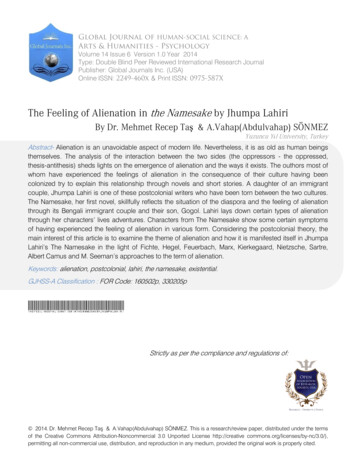
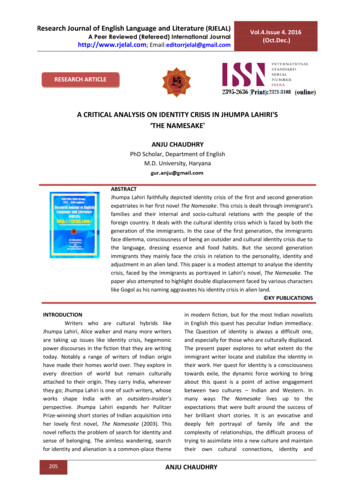
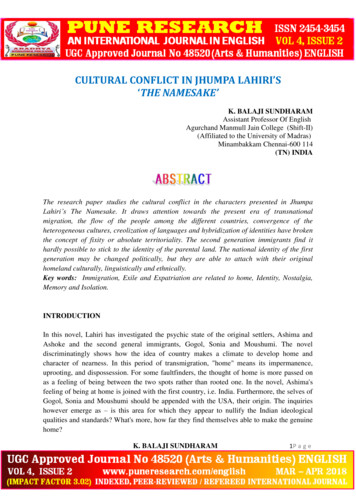
![JHUMPA LAHIRI [b. 1967] Interpreter of Maladies](/img/16/lahiri-interpreter-of-maladies-full-text.jpg)

